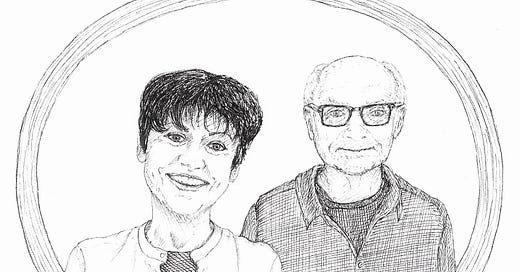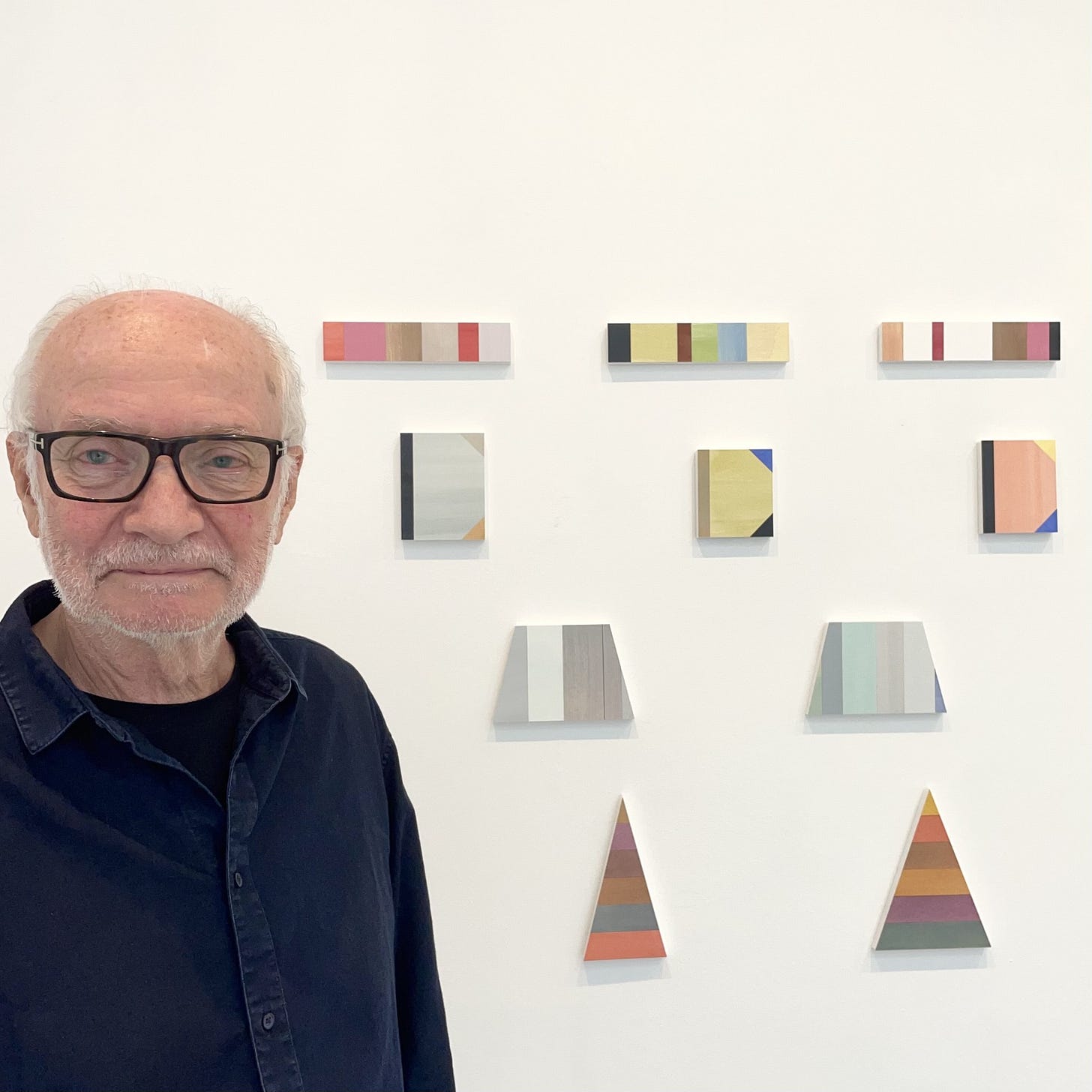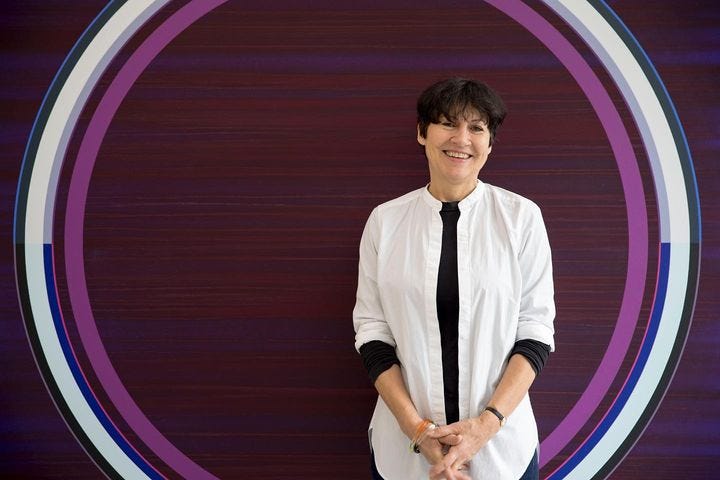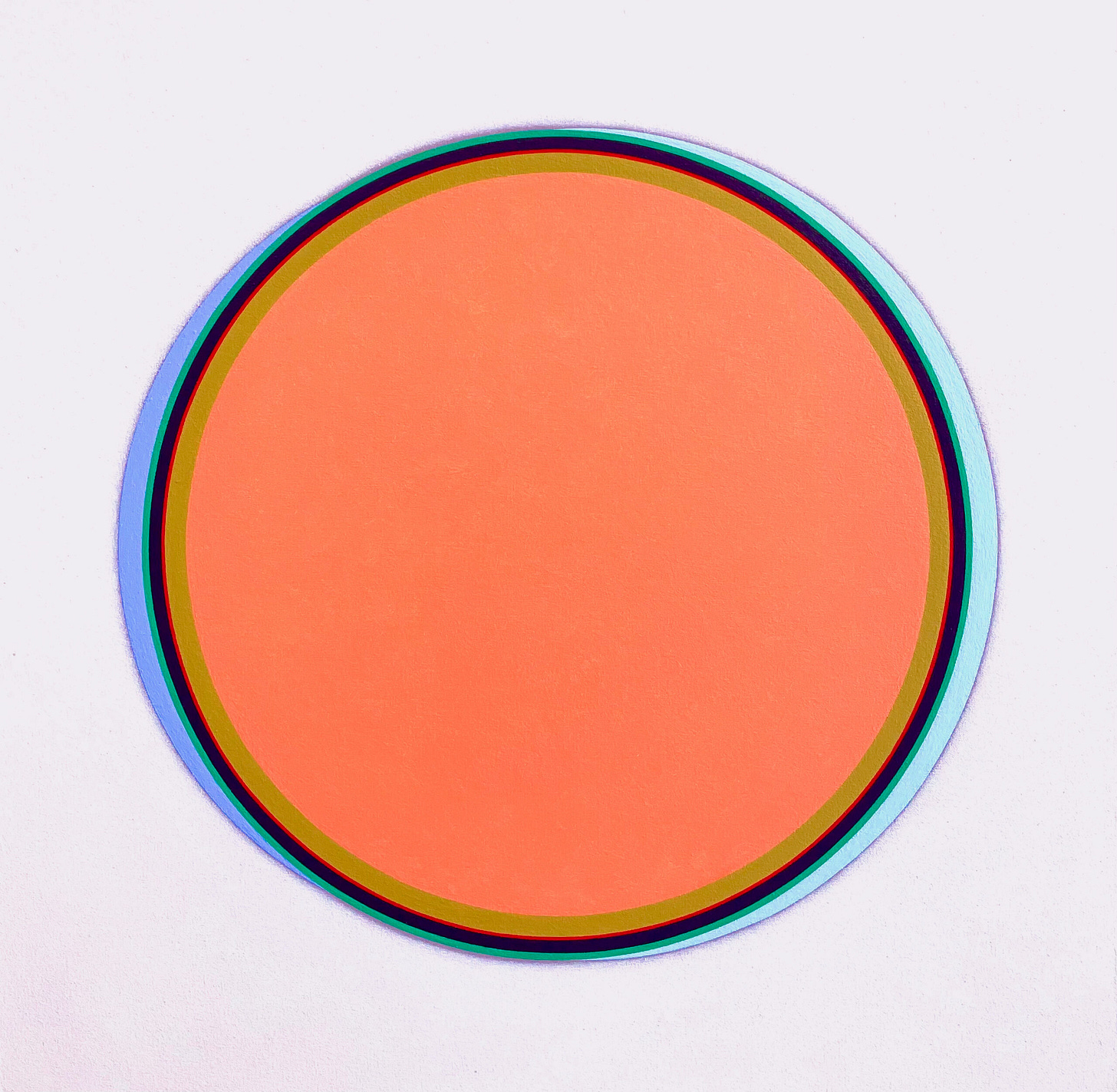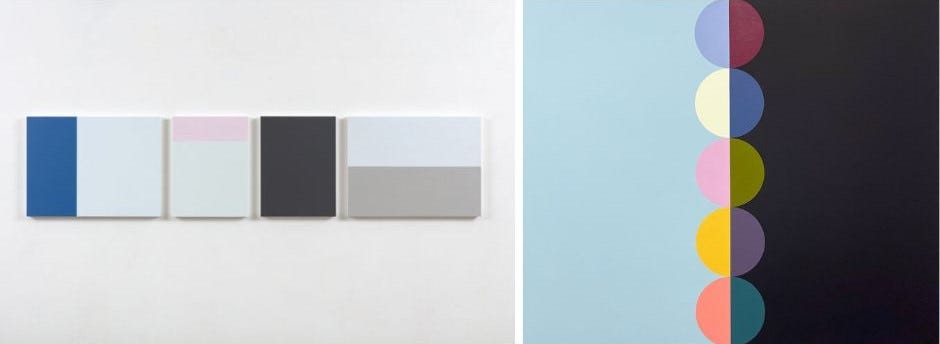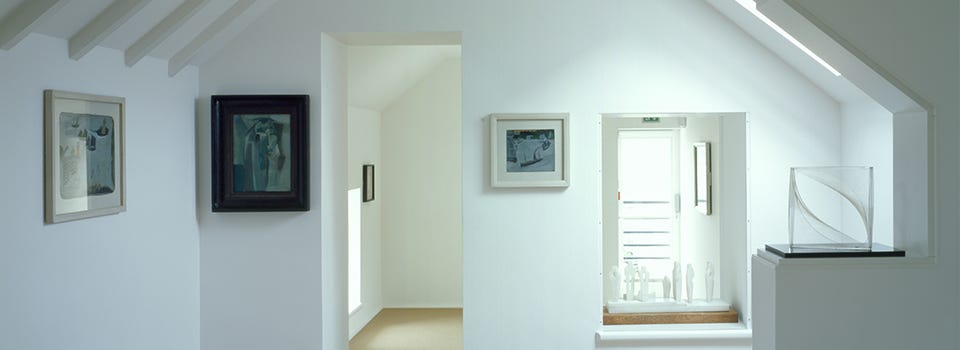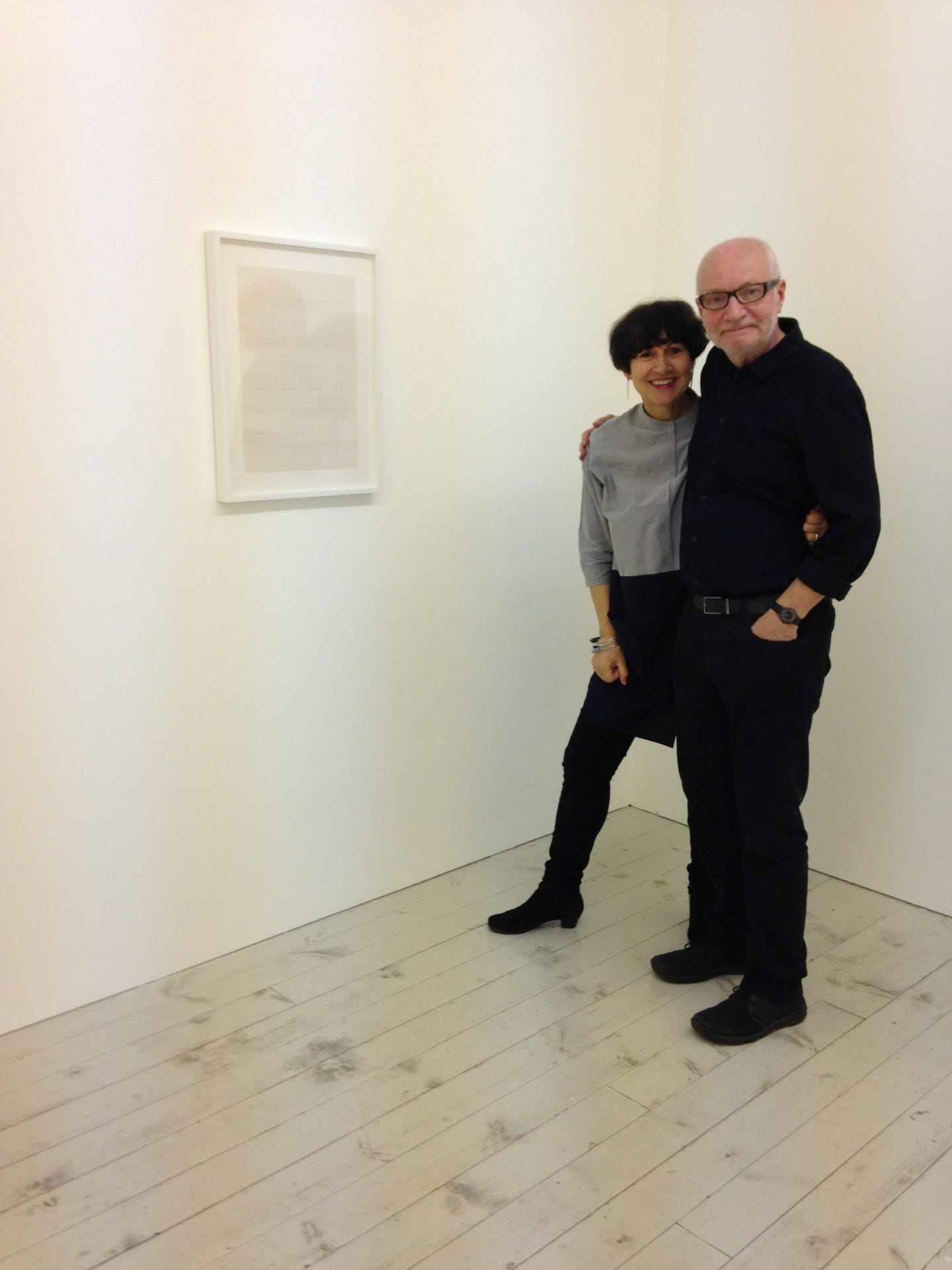Trevor and Carol are non-figurative painters living and working in East London. They have over four decades worth of experience working in the industry, to international acclaim.
Although their bodies of work are markedly individual, they share a common vocabulary: archetypal geometry as visual framework; a refined and carefully nuanced palette; and a minimalist, serene beauty that runs unerringly throughout their prolific outputs.
Oh, and they happen to be husband and wife.
I spoke to Carol and Trevor about their creative processes, their dream gallery lock-in, and how they have both relaxed into the exposing nature of working and exhibiting as professional artists.
How do you both get into the right frame of mind before you start working? We’ve all heard of ‘the flow state’ but is that something you actively pursue?
Trevor: I always work with music in the background. Usually instrumental, mostly jazz of some sort. That gets me in a rhythm or frame of mind that I can relax into and start thinking about the work. Because I can't just go and launch into it. I often read the newspaper or look at architecture or such - it's a slow thing. But once I'm in a state to work, I’m up and running.
Yet, I'm never afraid of thinking, I'm not going to work today. I don't mind that: I might go to the studio and just sit and think, read and look. That's also a valuable part of the process and time well spent.
The great thing about what I do is, when I go to my studio, I'm a young man again and it's magical. It makes getting up worthwhile.
Carol: I make much larger paintings than Trevor often, so I need the hours in which to make them. They're very meticulous, so it's a slow process. Once I start working, I'm absolutely in a meditative state without ego, I'm not thinking about the time. Sometimes I listen to music, but I think for me, the minute I enter the studio, I'm in a zone that's absolutely about working on art - That's not to say that, if you're an artist, and you're serious about what you do, that you're not an artist everywhere. You're an artist when you're walking down the street, you're an artist when you're talking to people, or travelling, looking at art, being with friends; you just are, it's part of your identity. As much as your gender or race, or where you’re from.
I work very instinctively, I don't always know what I want until I've tried something. If I've, as I have today, painted this huge area of deep blue with lots of purple in it, I'm offsetting that very spacey, recessed colour, with colours around it that are much hotter, brighter, creating a tunnel almost through which to look at this circle and painting. But I didn't know what I was going to do until I tried a few things. I have an idea, but it doesn't always work. So it's a reactive process.
You're an artist when you're walking down the street, you're an artist when you're talking to people, or travelling… it's part of your identity. As much as your gender or race.
Trevor, I have been looking at your grid paintings, and there’s so much nuance in them. Every picture is completely different, yet harmonious with the whole body of work. Could you talk a little bit about how you structure your work, and how the grid influences you in this regard?
Trevor: Yes, the grid is always underpinning what I'm doing. So, it is horizontals, verticals, right angles. I want to describe it as a safety net, it stops me having to think, ‘am I inventing something new?’ It enables me to create my own architecture for the work.
I have a fascination with finding new configurations, it’s ceaseless and very exciting, and the use of colour reinforces the illusion of three dimensions: So, I don't feel all the time that I'm working two dimensionally, because there's always a great deal going on.
I make paintings and works on paper, and they reference very strongly external, observed, architecture; both old and new. But also my own personal architecture, internal thoughts, fantasies; my ideal world.
Since I was a small child, I've always been interested in playing with toys, you know; small things, small worlds. So I make work that is relatively small because it's something I can deal with and enjoy. The grid is just one element, but it’s crucial because it allows me to do that.

Carol: Yes, I use geometry, like Trevor does, because it takes the chaos out of all the other multiple choices one might have. It's a support structure. So the circle (which I use most commonly) is almost like the head might be to a portrait painter. It's the place where you start and then you load, whatever it is you wish to say, into it.
I heard you state in a previous interview, Carol, that ‘the drawing and painting process reveals the self to the self’. How deep exactly does that go?
Carol: That's a very good question, because it’s right at the heart of my practice and profoundly important. That sense of self is always there; it’s the core. If I do things that feel false or wrong, the painting has to go or it has to be radically corrected in some way. I have to be true to something and I can't exactly name what that is.
It’s like how bad it feels if you lie. When I was little my mother always knew if I was lying. “No, I didn't take the last biscuit…” I had and she'd somehow know. I think from an early age, you’ve got to work out for yourself a code of practice that's yours. And this translates to art practice; if you go against that, you're going against yourself. That doesn't mean you can't take risks - being experimental and adventurous is a huge part of being an artist. But that sense of self is absolutely there. And sometimes if I'm rushing, or am aware of the fact that I've got a short amount of time, perhaps feel distracted, I might cut some corners. And I know instantly that I've messed it up, that I've broken my own code somehow.
Trevor: When I was a student, somebody once said to me that every painting you do is a self-portrait, whether it's figurative or abstract, or somewhere in between. I do think there’s some truth in that.
If I do things that feel false or wrong, the painting has to go or it has to be radically corrected in some way. I have to be true to something and I can't exactly name what that is.
I’d love to know how you both manage the vulnerability that’s inherent in exhibiting work publicly?
Carol: There is a vulnerability in exhibiting and I think all artists feel it. It's almost like undressing yourself in public; you're revealing yourself to other people. And we do still get nervous, both of us, about an exhibition. I think if we didn’t, there'd be something wrong. It's because you care and it matters that you get nervous. But overall it’s a mixture of nervousness and excitement.
Trevor: One of the lovely things about having an exhibition of your own work is the dialogue that is created not only with the space, but with the different pieces of work; how are they related to each other? Do they in fact, relate? And there are wonderful spaces, there are difficult spaces, but they're all unique and interesting.
Every painting you do is a self-portrait, whether it's figurative or abstract, or somewhere in between
Trevor, you alluded earlier in the interview that over time you have become ‘more philosophical and relaxed’ about your art practice, could you describe that shift?
Trevor: I think there is something about experience - that you feel more comfortable with things, just as a fact of life. You know, I'm in my mid seventies, so I'm no longer a young man. But the great thing about what I do is, when I go to my studio, I'm a young man again and it's magical. It makes getting up worthwhile. That's why I don't beat myself up. I want to keep that magic intact. You know, whether people like the work or not. It’s joyful.
Carol: Yes that confidence about selling and showing your work grows the more you do it. You're not asking anymore, should I be an artist? You just accept that you are.
And we have extremely bad days, months sometimes! You keep doing things wrong and you think, “Oh my God, what have I learned in all these years?!” But you work through it with strategies - break the cycle, have a day off, go and look at some exhibitions or talk to somebody, go for a walk, read a book…
That’s so reassuring to hear! Ok, I want to end with a slightly more frivolous question: if you were both locked in a gallery over-night so you had free reign of the space, which one would you choose, and why?
Trevor: I have very fond memories of Louisiana gallery in Denmark. It’s situated on the coast where it looks directly across the sea, with part of the museum going underground. There's a beautiful restaurant that looks across at a sculpture park.
Carol: Yes Louisiana has a Giacometti, and for a while, it had a Francis Bacon painting on the wall, with one whole side of the room as a glass wall that looks out on a beautiful pond. It's the most stunning room.
Trevor: But there's a particular gallery that means a lot to us, I don’t wish to speak on Carol’s behalf but I suspect she will agree, which is the Pier Gallery.
Carol: Yes, it’s in a very special location and the quality and nature of the work that's in the collection is fantastic. It's actually very tiny, but wonderful.
Trevor: It’s particularly close to our hearts because there is work in the collection by our dear friend, the late Roger Ackling. But I also think it's just about being there - being on Orkney (in Stromness, Scotland), coming in on the ferry and going into the port to this small gallery. It’s a very special place.
Fantastic - we will lock you in the Pier Gallery, perhaps with some cheese and a bottle of wine! Thank you both so much for speaking with me.
That sounds lovely. It was our pleasure.
I ask every interviewee what culture they have been enjoying. Here are some of Carol & Trevor’s favourite recommendations:
MUSIC
The Next Door by Julia Hülsmann Quartet
Sphere by Bobo Stenson Trio
Travel by The Necks
BOOKS
Modern Buildings in Britain - A Gazetter by Owen Hatherley
A Waiter in Paris - Adventures in the Dark Heart of the City by Edward Chisholm
Entangled Life by Merlin Sheldrake
Perdendosi by Norman McBeath and Edmund de Waal
Enquiries into Carol & Trevor’s work are taken by Flowers Gallery London
You can view their respective portfolios here:
Carol’s Instagram

